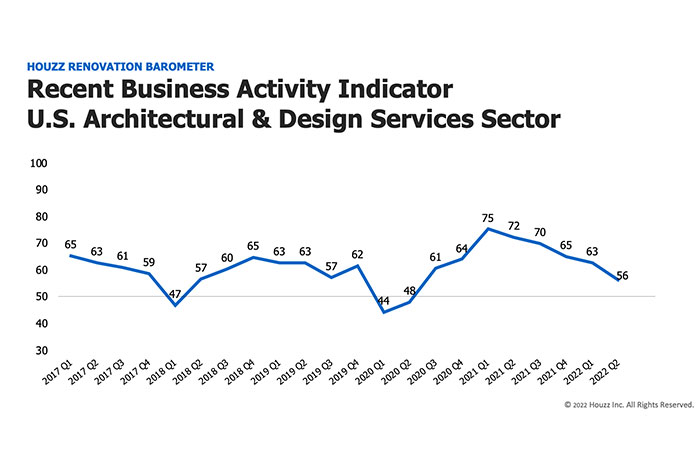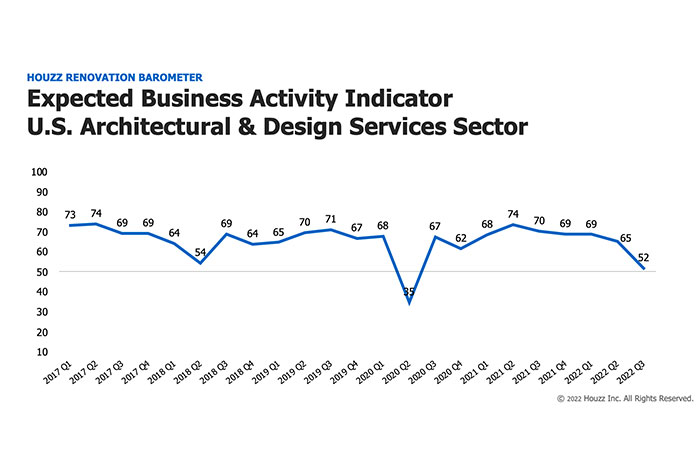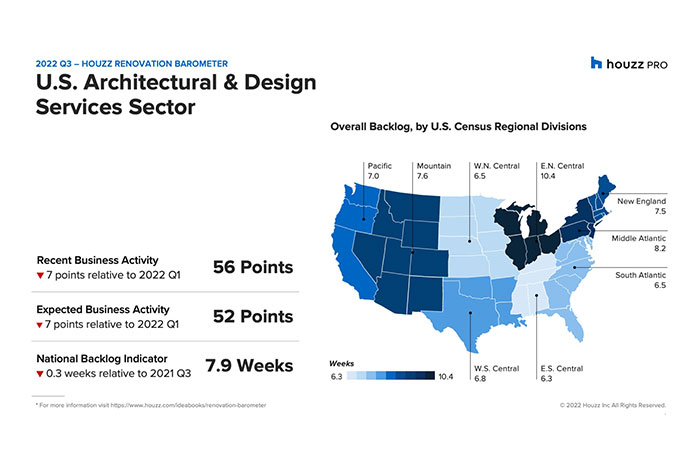Houzz Renovation Barometer Indicates Continued Yet Slowed Growth

July 21, 2022
Houzz Inc. released the Q3 2022 Houzz Renovation Barometer, which tracks residential renovation market expectations, project backlogs and recent activity among businesses in the construction sector and the architectural and design services sector in the U.S. The Barometer, which was fielded from June 30 through July 11, 2022, provides timely insights into the impact of recent economic volatility on the home renovation market. While the majority of businesses across both the construction and architectural and design services sectors reported more increases than decreases in recent business activity, expectations for continued demand are tempered as homeowners await signs of national economic stability. Meanwhile, following record high wait times before professionals can begin work on a new midsize project, businesses report that backlogs are decreasing across the industry.
“Following the strong residential remodeling and design activity of the past two years, it’s unsurprising that businesses are leveling their expectations as current economic conditions now impact both sides of the industry,” said Marine Sargsyan, Houzz staff economist. “Rising interest rates and inflation have put downward pressure on homeowners’ demand for professional services in the short term, giving pros an opportunity to clear up lengthy backlogs. That said, homeowners managing the demands of aging housing stock and housing market shortages will continue to drive home renovation and design activity in the long run.”
Q3 2022 Construction Sector Barometer
In the construction industry, build-only and design-build professionals are aligned on anticipated business performance and recent business activity. As project inquiries declined significantly in Q2 2022 among the two business groups, both have lowered their expectations for new committed projects in Q3 2022. Regionally, expectations for business activity are highest among New England firms (69), and lowest among professionals in the Pacific division (46).
- The Expected Business Activity Indicator related to project inquiries and new committed projects decreased to 62 in Q3 (compared to 67 in Q2). Expectations for project inquiries declined to 62, compared to 65 in Q2, and new committed projects reduced to 63, down six points relative to expectations in Q2 (69).
- The Project Backlog Indicator is 10.5 weeks in the beginning of Q3, a return to similar wait times from a year ago after reaching a five-year peak in Q2 (12 weeks).
- The Recent Business Activity Indicator related to project inquiries and new committed projects declined to 63 in Q2. This reflects an eight point drop from Q1, however it is five points higher than the same period prior to the pandemic (58 in Q2 2019). This is driven by a ten-point decline in project inquiries in Q2, relative to the previous quarter, and by a decrease in new committed projects to 65 (72 points relative to Q1 2022).
Q3 2022 Architectural and Design Services Sector Renovation Barometer
Business performance expectations somewhat diverge among the architectural and design services subsectors. While the expected business activity indicator has declined among the two business groups, interior designers present a more optimistic view than architects. Both groups report slower business activity in Q2 2022 compared to the previous quarter. Regionally, expectations for business activity are the highest among the businesses in the East South Central division (61) and the lowest among businesses in the West North Central division (46).
- The Expected Business Activity Indicator related to project inquiries and new committed projects declined to 52 in Q3, with interior designers at 68 points versus architects at 42 points. This decline in the overall indicator is primarily driven by lowered expectations for new committed projects at 51 in Q3 (down 17 points relative to Q2). Expectations for project inquiries are also down 11 points in Q3 (52 compared to 63 in Q2).
- The Project Backlog Indicator is 7.5 weeks in the beginning of Q3, slowly returning to wait times experienced one year ago (7.2 weeks in Q3 2021) after reaching the highest levels since 2017 in Q4 2021 (9.3 weeks) and down slightly from Q1 and Q2 2022 (7.9 weeks).
- The Recent Business Activity Indicator related to project inquiries and new committed projects declined to 56 in Q2 (compared to 63 in Q1 2022), with interior designers at 62 versus architects at 53. This decline is the result of a drop in project inquiries to 55 (compared to 62 in Q1 2022) and a decrease in new committed projects to 57 (down six points from Q1 2022).
Regional Backlogs
For the construction sector, the New England division (including Connecticut, Maine, Massachusetts, New Hampshire, Rhode Island and Vermont) has the longest backlog (13.8 weeks) driven primarily by build-only firms in the region (14.4 weeks), while design-build remodelers report 13.3 week wait times. Businesses in the Mountain division (which includes Arizona, Colorado, Idaho, Montana, New Mexico, Nevada, Utah and Wyoming) report backlogs of 9.2 weeks before they can begin a new project, the shortest wait time reported by construction firms among the nine Census divisions. Compared to the same quarter one year ago, backlogs for the construction sector are longer across five of the nine Census divisions (East South Central, Middle Atlantic, Mountain, New England and West South Central divisions).
Backlogs also vary across all regional divisions among businesses in the architecture and design services sector. Businesses in the East North Central division (including Illinois, Indiana, Michigan, Ohio and Wisconsin) reported 10.4 week backlogs, while the East South Central division (including Alabama, Kentucky, Mississippi and Tennessee) showed much shorter backlogs at 6.3 weeks. Backlogs reported by architects (13.7 weeks) in the East North Central division are the driving force for long wait times, whereas wait times to begin a new project with an interior designer in that area is only 4.9 weeks. Compared to the same quarter one year ago, backlogs for the architectural and design services sector are longer across five of the nine Census divisions (East North Central, East South Central, Mountain, New England and West North Central divisions).
More News
April 19, 2024 | Business
How K&B Brands Handle Product Quality Control
April 19, 2024 | Business
Artistic Tile Paramus Unveils New Location
April 18, 2024 | Business, People
Excelling at Kitchen Design When You Don’t Like to Cook
April 18, 2024 | Awards & Events
KCMA Design Awards Announces Winners
April 17, 2024 | People
WAC Lighting Promotes Becky Li to President
April 2, 2024 | Sponsored
Whirlpool Corp. Brings Purposeful Innovation Home

